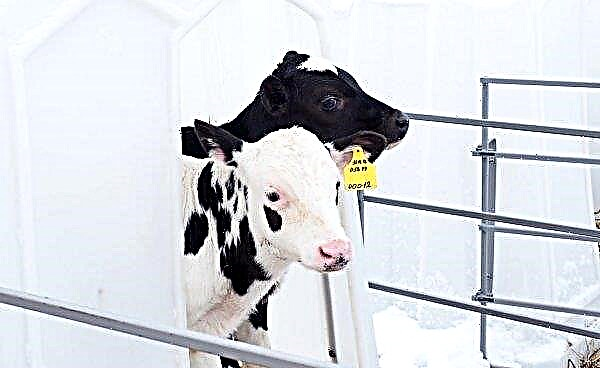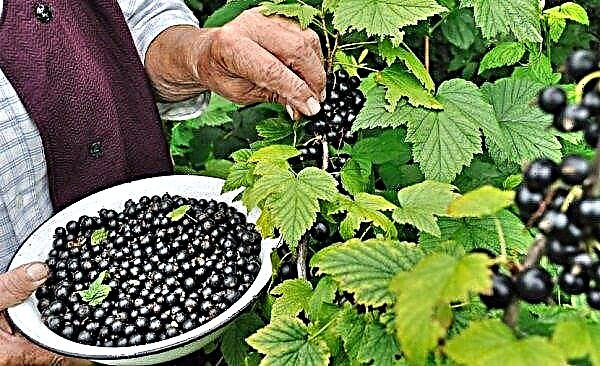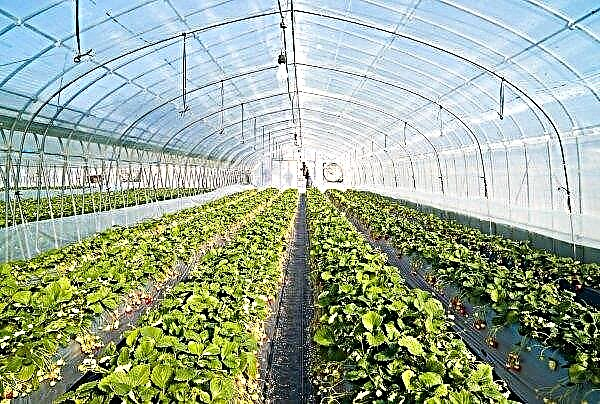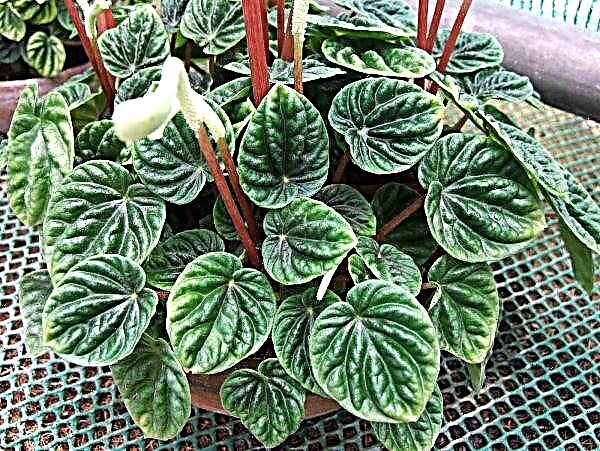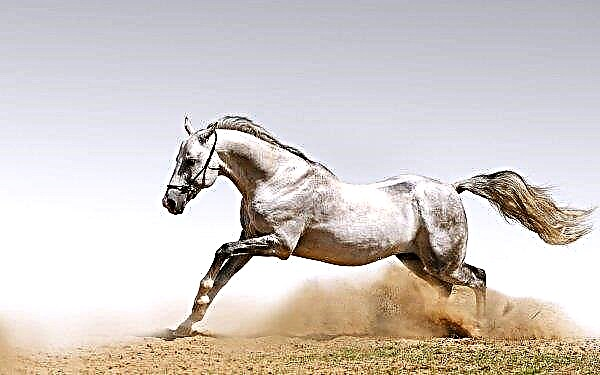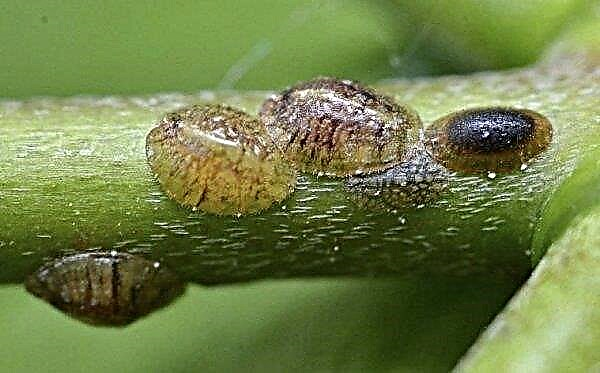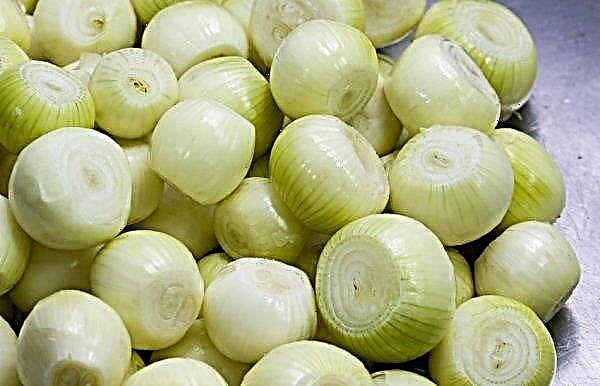Turkey meat is a dietary and nutritious meat, beloved in many countries. Breeding turkeys for meat and eggs has every chance of becoming a profitable business, so raising this bird is popular both in poultry farms and in farmsteads. Care and care for the health of birds are fundamental to their maintenance. Monitoring the diet, drawing up feeding programs and including the necessary components in it is the key to the development of resistant to external factors, active and prolific birds.
How can adult turkeys be fed?
Adult turkeys are unpretentious in food, but they have features. To control the mass, provide a diet that will include all the necessary vitamins and minerals. Feeding is organized 3-4 times a day, in breeding periods this indicator reaches 5 approaches. It is important not to overfeed the bird, as excess fat makes turkeys lethargic and slow in development. The norm of the weight of males is 11―19 kg, females 9―12 kg.
Did you know? From the union of a domestic turkey with a wild turkey, stronger offspring are born than with a domesticated male.
The breeding period in birds is from two to four times a year. A month before mating, the breeding males and females are separated from the main herd and provide them with a special diet. At this time, the males require additional protein in the form of grains, and granulated yeast and sprouted wheat are added to the lure of the females. During this period, the need for calcium and chalk increases. The following elements should be included in the diet of birds:
The following elements should be included in the diet of birds:
- Proteins and carbohydrates. Affect mass gain and development.
- Fats. The basis of energy, but their indicator in the daily diet should not exceed 7%.
- Calcium and phosphorus. Necessary for the formation of an egg shell and general strengthening.
- Vitamins A, E, B, C. The basis for the development, development of immunity and disease control.
- Cellulose. Improves digestion.
- Salt, sugar and minerals. They are added in small quantities, but are the basis for the construction of tissues.
An additional source of fat is sunflower meal. During the day, they monitor the presence of clean water in the house inside and out. Mandatory “dishes” are dry and wet mixers. The former are served for breakfast and dinner, and the latter for lunch. Dry mixers can be a combination of cereals and legumes, corn, buckwheat, dried fruits.
Important! Do not leave leftovers on underfed wet mash. Over time, they turn sour and rot, which threatens poisoning of birds.
Wet mixers include boiled pumpkin, potatoes, carrots, beets, greens and grains sprinkled with broth. For beginner farmers, there are different options for ready-made compound feeds that contain the above components. Consider the pros and cons in feeding birds with the following products:
Consider the pros and cons in feeding birds with the following products:
- Wheat. It has a large amount of vitamins necessary for birds. Contains less carbohydrates and more protein.
- Bread. Yeast bread is good for chicks at the age of three months. You can not give white bread fresh, as it swells and causes obstruction of food. However, dry white bread is recommended.
- Duckweed. Water grass contains many essential vitamins, and is recommended for addition to wet mixes.
- Barley.A great supplement to a protein diet.
- Cabbage. One of the options for green food.
- Buckwheat. Cereal feed and one of the essential foundations of the diet. Served boiled.
- Porridge. They can serve as options for wet mash. For increased nutrition, they are boiled in milk with the addition of salt and sugar.
- Pumpkin. It is recommended to give boiled and raw pumpkin. Source of fiber.
- Corn. Silo option. Corn is given fresh in the summer (along with tops) and canned in the winter.
- Fish. You can not give directly the fish itself, as small bones can injure the larynx of turkeys. As food, fishmeal is used as a source of phosphorus.
Feeding turkey
The diet of turkey poults at different periods of development is different, because in the first days the chicks are especially sensitive and require reverent care. The introduction of certain types of feed should be gradual and not cause harm. An important role is played by the weight norm of nutrition, we consider it in the table. The norm in grams is indicated per day.
| Age weeks | Norm of feeding, gr |
| 1 | 10 |
| 2 | 25 |
| 3 | 40 |
| 4 | 60 |
| 5 | 75 |
| 6 | 90 |
| 7 | 110 |
| 8 | 130 |
| 9 | 155 |
| 10 | 175 |
| 11 | 200 |
| 12 | 220 |
| 13 | 235 |
| 14 | 250 |
| 15 | 260 |
| 16 | 280 |
| 17 | 285 |
| 18 | 290 |
| 19 | 295 |
| 20 | 295 |
| 21 | 300 |
| 22 | 305 |
| 23 | 310 |
| 24 | 310 |
| 25 | 300 |
| Adult females | 260 |
| Adult males | 500 |
1 month
The body of the chicks is fragile and requires dietary control. Chicks separated from their mother are reluctant to take food, therefore they are helped and their attention is additionally attracted to feeders (special feeders for young animals with mechanical sound effects are on sale). Chicks growing up with their mother understand everything intuitively. It is important to provide a varied diet to enrich the body with a large number of nutrients. In the early days, poultry is fed every 3 hours. Give yogurt, fermented baked milk, chopped cottage cheese, grain wet mixtures of uniform mass and warm water. From the second day, the mixtures are sweetened and chopped boiled eggs, corn grits, wheat bran, and crushed dry herbs are gradually introduced into the diet. These components can be kneaded in sour milk or skim milk (skimmed milk using a separator).
In the early days, poultry is fed every 3 hours. Give yogurt, fermented baked milk, chopped cottage cheese, grain wet mixtures of uniform mass and warm water. From the second day, the mixtures are sweetened and chopped boiled eggs, corn grits, wheat bran, and crushed dry herbs are gradually introduced into the diet. These components can be kneaded in sour milk or skim milk (skimmed milk using a separator).
Important! The body of turkey poults in the first days should receive protein and vitamins, and not contain fiber, as it is considered "heavy food" and can cause digestive upset.
The latter is useful for the development and growth of young chicks. You can replace yogurt. From the 7th day, chopped greens (onions, nettles, clover, dandelions) are added to the chicks. The basis of calcium can serve as crushed shell soaked in milk. In the early days, they monitor the reaction of the chicks to food, in order to avoid negative consequences. From the 10th day, turkey poults can be released on a paddock, where they independently supplement the diet with fresh pasture.
2 months
The turkey poults are already strong and can process more “heavy” food, which nevertheless must be in a softened form. Starting from this period, turkey poults are fed 3-4 times a day. Bran, kitchen salt is added to the existing diet, a decoction of their potato peelings is made. Boiled vegetables are needed: potatoes (a source of starch), carrots (a source of vitamin A). Wheat grain contains calcium, copper, zinc, iodine and iron. At this age, crushed dry nettle (vitamin E), fish meal, hay flour (vitamin B2, E), grated mountain ash (vitamin C) and needles (has a large number of biologically active components and vitamin E) are introduced into the feed.
Wheat grain contains calcium, copper, zinc, iodine and iron. At this age, crushed dry nettle (vitamin E), fish meal, hay flour (vitamin B2, E), grated mountain ash (vitamin C) and needles (has a large number of biologically active components and vitamin E) are introduced into the feed.
3 months
At this age, increase the weight rate and calorie intake. Dry animal feed (amino acids), crushed corn (vitamin B, E, H), bone meal, oats (carbohydrates, proteins, fats, vitamin B) are introduced, the amount of greenery is increased (large leaves are crushed). Continue to give hard-boiled eggs, cottage cheese and yogurt. Feed can no longer be crushed, but given in its entirety.
4 months
Poultry are fully transferred to an adult diet. The norm of corn and bone meal is increased, meat flour, chalk and shell, legumes are introduced, the dose of salt is increased. Foods containing fat (lard, acorns, nuts) in the diet of young chicks will affect the quality of their meat in the future. Sunflower meal - seeds kernels crushed after squeezing, a source of protein, crude fats and crude fiber. Useful for young animals to gain weight, improve digestion and metabolism, accelerate growth.
Norms of fattening turkeys for meat
You can slaughter turkeys for meat from 4―5 months of age, when they reach 10 kg or more. Prepare for slaughter in a month. From this time, they increase the diet of birds, focusing on protein and fats. Moreover, the components should not affect the increase in body fat, but on the increase in fat mass.
Did you know? Turkey meat is dietary and contains vitamins of groups A and E. It is characterized by a mild taste and lack of cholesterol. Turkey meat is low-calorie and has easily digestible fats. Tryptophan, which is part of meat, has a beneficial effect on the nervous system.
Increase bird walking time. Below is a table with daily rates of fattening, which begin 30 days before slaughter:
| Feed | Norma, gr |
| Corn, barley, oats | 350 |
| Wheat bran | 50 |
| Corn | 80 |
| Vegetables (carrots, beets, pumpkin) | 60 |
| Boiled potatoes | 120 |
| Meat and food waste | 100 |
| Meat and bone meal | 15 |
| Salt | 3 |
| Shell | 10 |

Winter feeding
Feeding turkeys in the cold season should provide birds with the same amount of vitamins and fiber as in the summer. To avoid freezing, adult turkeys and young animals need extra energy. It can be provided with feed rich in carbohydrates and fats.
Adults
Adult turkeys are fed three times a day in the autumn-winter period according to the previous scheme: dry breakfast and dinner, and wet mixes for lunch. Feed has been harvested since the summer. For example, in the house you can hang wreaths of herbs, birch and mountain ash. An important food in the winter diet is silage. It should be harvested since the summer. Silo can be single-component and multi-component. The most nutritious silo with three or more components.
Did you know? Turkeys began to be appreciated for meat only 300 years after their distribution in Europe. Initially, they were bred solely for the beautiful plumage.
Turkey
The diet of turkey poults differs from the diet of adult birds only in quantity. Chicks should also receive a sufficient dose of energy and vitamin components. Such a component is shredded needles of needles, hay flour, herbal mixtures of dry greens (alfalfa, clover, birch, nettle). Do not forget about silo.
Summer feeding
In the summer, the cultivation of turkeys is facilitated by the presence of green and pasture. The cost of grain is reduced, since most of the diet of the bird is mined during the day on their own. This greens, cassock and pestle on the lakes, which contain a lot of fiber and trace elements, improve metabolism. As a rule, feeding in the summer months is carried out 4―5 times a day. The diet during this period remains the same, but differs in the translation to fresh fruits and herbs.
Most vitamins are obtained from turkeys walking. It is common for a turkey to avoid harmful plants, so there is no need to worry about it during independent walking. It is important to release them in the summer for “free range” for at least 10 hours (outdoor temperature at least +20 ° C).
What can not be fed?
Errors in the preparation of the diet:
- The quality of the feed. After purchasing feed from a new producer, give it in a small dose and monitor the reaction of birds after eating. The better the quality of the feed, the healthier the livestock.
- The body of young chicks is not able to digest fiber, animal feed and whole grains (e.g. barley and oats). In the first days of life, the remaining products also give only in crushed form.
- Small and adult birds will be hurt by fresh white bread, since after swelling it causes food obstruction.
- It is not recommended to give turkeys leftover homemade food from the tables.
- Fresh meat and fish are harmful - cause indigestion. Fish bones can get stuck in the throat or scratch it.

Feeding turkeys in poultry farms
In poultry farms, birds are kept in poultry houses, aviaries or cages. Based on the scale of production, with such cultivation there is no individual approach to the bird and careful selection of the daily “menu”. The basis of the feed is the production of feed in granular form. They include: wheat, oilcake, corn, fish meal, calcium, chalk, salt, and such substances as methionine, lysine, threonine, sodium chlorine.
Combined feed is served both in dry form and soaked in water or dairy products. Some breeders provide birds with automated mixers of vegetables and grain. The food supply is calculated on the basis of the following standards: young chicks 3-7 days should receive 150 g of feed per day, and adult birds - 300-350 g males and 250 g of female. The purpose of growing turkeys at home and at poultry farms is to obtain high-quality meat and nutritious eggs. Turkey meat, as well as chicken, is a dietary product. In order to increase the useful and tasteful properties of meat, it is necessary to control the diet of birds and ensure its diversity. The quality of eggs depends on the production of vitamins and minerals by turkeys, which play a key role in building a strong egg shell. Despite the fact that a turkey is an unpretentious bird, it needs an individual and attentive care.
Turkey meat, as well as chicken, is a dietary product. In order to increase the useful and tasteful properties of meat, it is necessary to control the diet of birds and ensure its diversity. The quality of eggs depends on the production of vitamins and minerals by turkeys, which play a key role in building a strong egg shell. Despite the fact that a turkey is an unpretentious bird, it needs an individual and attentive care.

